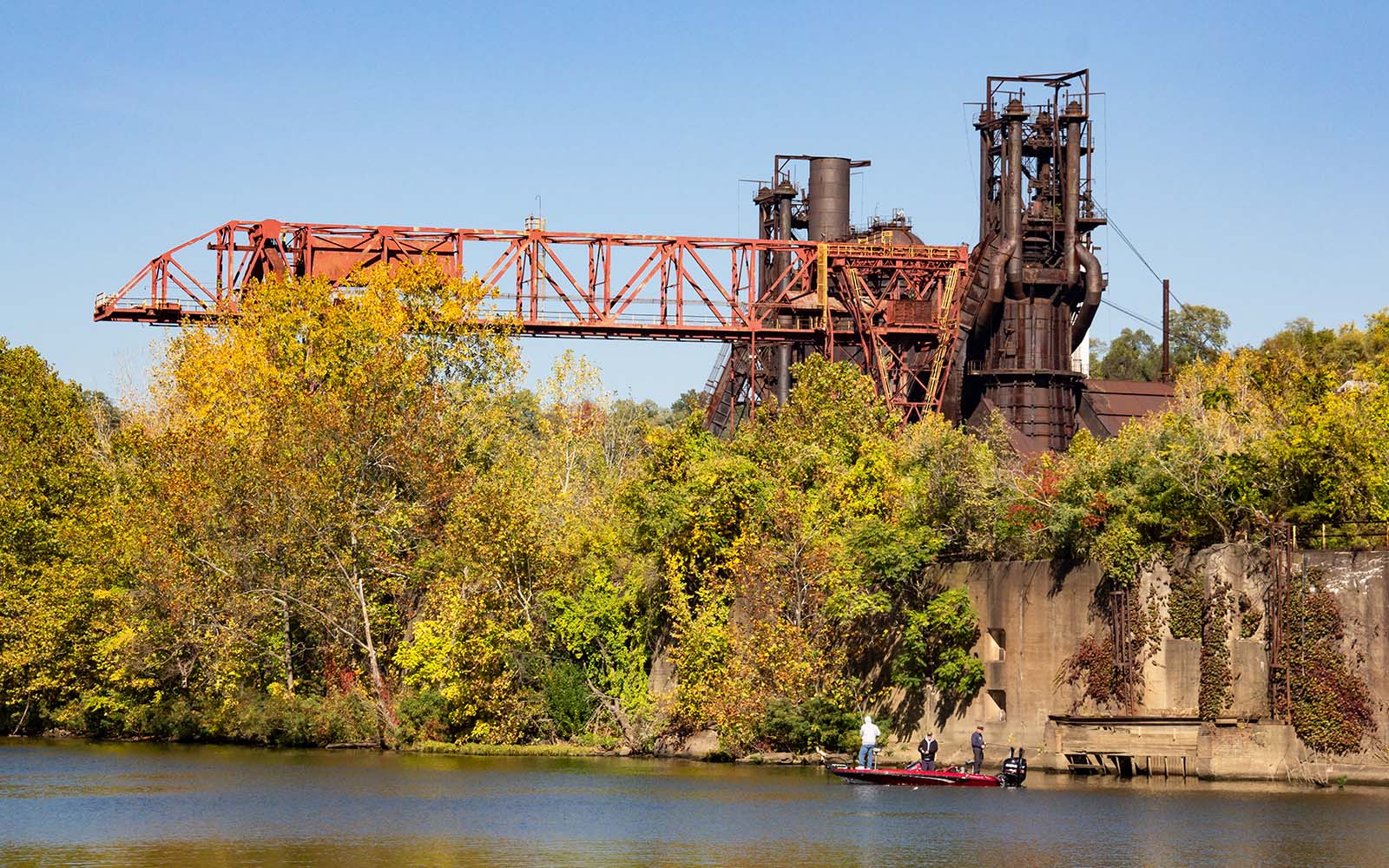
Men fish in the Monongahela River in front of the Carrie Blast Furnaces, a recreational activity that is far more common today than it would have been 40 years ago when the Furnaces were still operating.
By Suzi Bloom, Director of Education
 Environmentalism and Historic Preservation
Environmentalism and Historic Preservation
To coincide with World Environment Day, Suzi Bloom, Rivers of Steel’s director of education, reflected on our region’s industrial and ecological history, exploring the intersection of environmentalism and historic preservation—as well as just what the impact of our work as a National Heritage Area means for future generations.
National Heritage Areas—Exploring a Sense of Place
Many of us attended school in a time when each subject was taught as an independent entity from the other. History class did not mix with science class. And art class, well that was its own thing too. The beauty of National Heritage Areas is their ability to bring together various subjects as interconnected, with all facets being part of our collective experiences and sense of place.
When Rivers of Steel, an industrial heritage preservation organization, acquired RiverQuest, an environmental education nonprofit in 2016, I was often asked how an environmental science program that focuses on the health of Pittsburgh’s river ecosystems, could meld with an organization that talks about industrial heritage—as though remembering our past also glorifies the challenges that the past created.
With a mix of historical preservationists, public historians, artists, and environmental conservationists on the team at Rivers of Steel, it becomes obvious that we all have similar goals; albeit goals that are not traditionally viewed as commonalities. Our team works hard on the grassroots level to deepen community partnerships, promote heritage tourism, and preserve local recreational and cultural resources for future generations.
Remembering our regional environmental history helps us to reflect on our present challenges. Stories like Donora, Pennsylvania, a small industrial town that suffered from a deadly smog inversion in 1948. This incident later inspired the early drafts of our nation’s Clean Air Laws. And Pittsburgh’s Three Rivers—the Monongahela, Allegheny, and Ohio—have an environmental past is so complex, the stories that they could tell would go on for days!
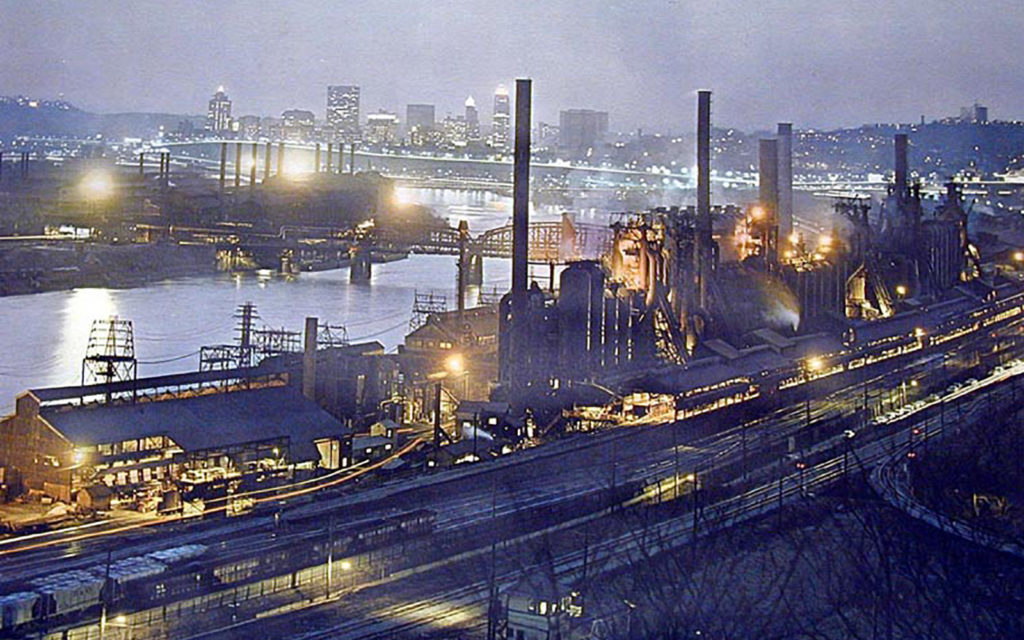
Jones and Laughlin works on the Monongahela River with downtown Pittsburgh in the background. Image from the Rivers of Steel Archives.
Pittsburgh’s Three Rivers—A Legacy of Commerce and Industry
We can look back on Pittsburgh’s long history of both our reverence for the rivers and our mistreatment of the rivers. Long before steel mills and other manufacturing dotted the river banks, the three rivers long served Indigenous Americans as corridors for movement and a source of food. In the early eighteenth century, the Seneca, Delaware (Lenape), Shawnee, and Mingo tribes utilized the region for hunting grounds and access points to trade with Euro-American fur trappers.
In the mid 1700s, the discovery of bituminous coal by European settlers led to the beginnings of our region’s air pollution. In 1758, the first mine in the region began supplying coal to the residents of Fort Pitt at the confluence of Pittsburgh’s Allegheny and Monongahela Rivers. Some reports list the Fort Pitt community as the largest user of coal on this continent for over three decades.
River access to the West, as well as the abundance of coal, was conducive in the rapid development of the region. Our resources led to our economic successes as well as to our environmental challenges.
By the 1800s several small industries, including the manufacture of iron and glass, began to spring up along the three rivers. Records indicate that as early as 1804, there were cries for public action over Pittsburgh’s smoke problems.
The rivers were also integral to interstate commerce, but drought and normal fluctuations in river flow often plagued the rivers, and left them too shallow for river traffic. Trade booms led the rivers being declared by Pennsylvania as public highways. This declaration sparked efforts to modify and deepen the navigation channels through dredging and installing wing dams, with both activities having the potential to impact river habitat including native fish and freshwater mussels.
In 1852, when the Pennsylvania Railroad opened and provided service between Philadelphia and Pittsburgh, the city’s access to coal, water resources, and access to the west was once again a catalyst for rapid industrialization and the shift to the steel boom began.
The rivers also served as a means of waste disposal, which included industrial waste as well as raw sewage. The city had the highest typhoid fever mortality rate of any city in the nation between 1872 and 1908. Additionally, river water was utilized for industrial processes. Estimates are that it took 70 tons of water to produce one ton of steel.
By 1930, R.L. Duffus wrote in the American Monthly, “From whatever direction one approaches the once-lovely conjunction of the Allegheny and the Monongahela, the devastation of progress is apparent. Quiet valleys have been inundated with slag, defaced with refuse, marred by hideous buildings. Streams have been polluted with sewage and waste from the mills. Life for the majority of the population has been rendered unspeakably pinched and dingy. This is what might be called the technological blight of heavy industry.”
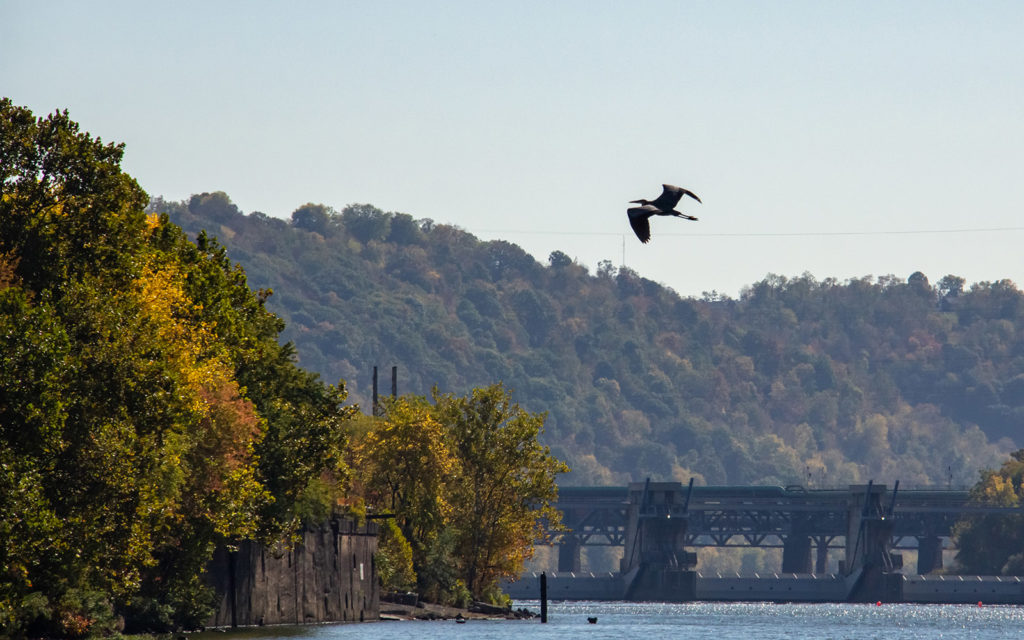
A crane flies towards the Edgar Thompson Works with the Braddock lock and dam in the background.
Deindustrialization and the Recovery of the Rivers
While throughout this entire time period, there were efforts and ordinances to control pollution levels in Pittsburgh, namely the air pollution issues, the eventual diversification of fuel sources led to some visible improvements in air quality.
Visionaries, Like David L. Lawrence who was elected mayor of Pittsburgh in 1946, also embarked on efforts to clean up the city. Lawrence’s “Renaissance I,” led to a 20-year redevelopment effort that resulted in significant reductions in smoke pollution as well as the construction of a major sewage treatment plant for the city.
The recovery of the rivers was perhaps a little bit slower, as many residents still viewed them as industrial assets rather than recreational assets. In 1957, surveys from the Elizabeth, Pennsylvania lock and dam area of the Monongahela River document a pH of 5.7 and only two bluegill sunfish. And even years later, in 1970, when Three Rivers Stadium was constructed, despite its name, it was built without views of the rivers.
A painful part of history soon followed with U.S. Steel’s mill in Duquesne closing in 1984; the Homestead works shuttered in 1986; followed by National Tube and American Bridge in 1987. By 1985, almost all of LTV’s Aliquippa works was idled, as was the Southside Works. The next year, Wheeling-Pittsburgh closed its Monessen factory.
From 1979 to 1987, the Pittsburgh region lost 133,000 manufacturing jobs. Some of those jobs vanished into obsolescence because new technologies led to improved productivity, and many more drifted overseas and into nonunion mills. Foreign steel was everywhere and new environmental regulations in the United States were also hurdles for industry.
Deindustrialization was happening across the country, but in few places were the forces of globalization felt so acutely—and so abruptly—as in Pittsburgh. While deindustrialization was devastating to the region, it allowed for additional recovery of our environment.
In the years since, industrial and environmental regulations like the Clean Water Act, along with concerted efforts from community players, have restored the ecosystems on the rivers surrounding Pittsburgh. A fish sample like the one done in 1957 would potentially return hundreds of fish—there are now at least 80 species in the Mon.
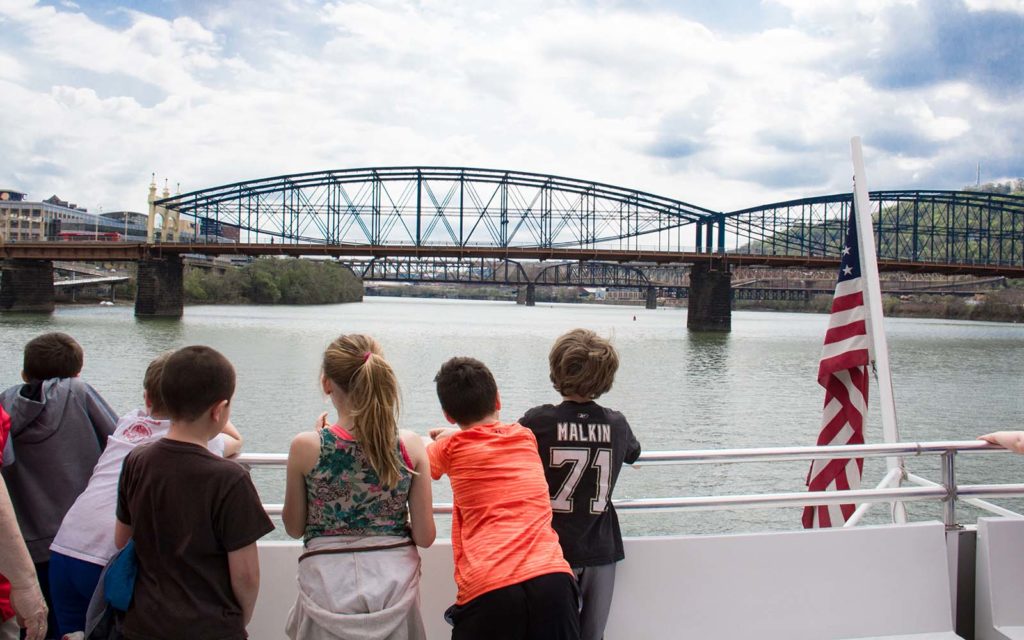
Student scientists on the Explorer riverboat look out towards the Smithfield Street Bridge.
Environmental Science on the Three Rivers
Each summer Rivers of Steel’s Explorer riverboat is coated in Mayflies. These insects spend up to two years foraging on the river bottom before they emerge from the water as an adult flying insect where they live the briefest of lives—sometimes as little as two hours—with just enough time to reproduce to start the life cycle over again. That said, they are indicators of improving water quality.
Students participating in Rivers of Steel’s Environmental Science on the Three Rivers program onboard the Explorer riverboat, now collect data to show that our rivers frequently test at an acceptable pH level between about 7.0-8.4.
Our goal for the environmental science program, which in a typical year welcomes aboard approximately 3,000 students, is to not only provide students with a STEM experience, but to offer transformational experiences involving our rivers and to instill in students a love for the natural resources found in their city. We want students to go home and tell their families about all of the cool plankton, birds, and macroinvertebrates that they saw during their field trip. Signs of life, that not all too long ago, were not very common on the three rivers.
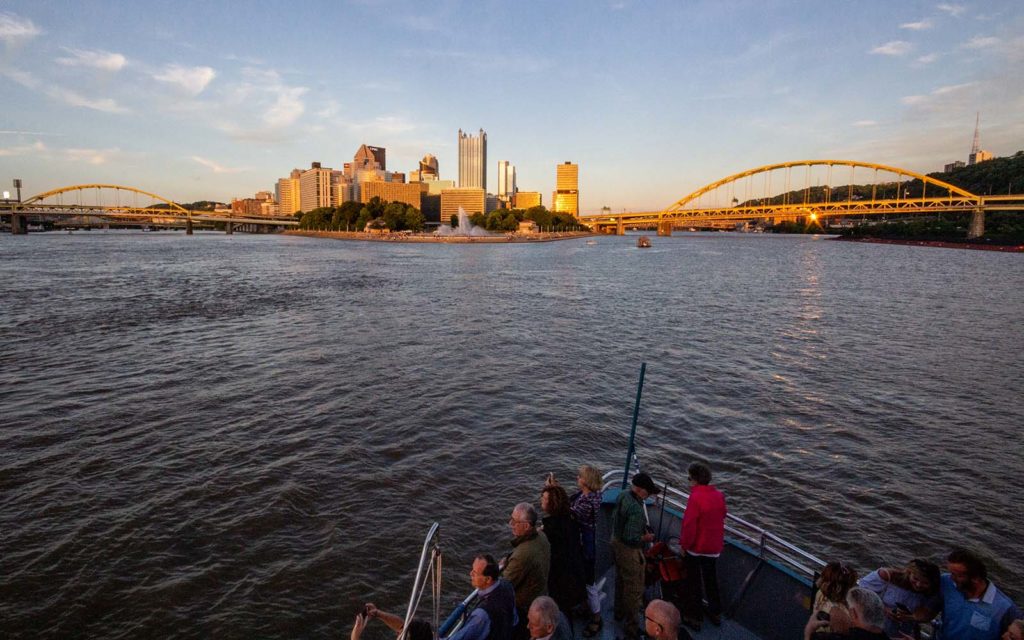
Guests on the Explorer riverboat take in the view as the sun sets on downtown Pittsburgh.
The Here and Now of Climate Change
As we enter this latest chapter on climate change research and issues of environmental justice, many of us are looking for things that we can do to protect our ecosystems. We’ve grown beyond the phrase reuse, reduce, recycle, to more complex issues like carbon credits and more importantly, worrying about our children’s futures. We now challenge the concept that the zip codes we were born into all too often determine our destiny when it comes to asthma rates and life expectancies.
A changing climate could mean more frequent or powerful storms that increase the amount of sediment runoff into our rivers. Pittsburgh is also still managing the retrofit of aging combined sewer infrastructure, a system in which stormwater and sewage are transported together in one pipe. Heavy storms can overwhelm this system, leading to higher instances of raw sewage releases into our rivers.
Changes in climate could impact the ecosystems and environmental conditions for our freshwater fish species and macroinvertebrates. Organisms whose survival is often based upon certain water temperatures or stream flow conditions. The loss or weakening of native species can lead to non-native or invasive species becoming more established. Floods or high water can also scour out communities of native mussels, some of which are already listed as endangered species.
In a 2013 survey of local attitudes and awareness of environmental issues, conducted by PittsburghTODAY and University of Pittsburgh’s Center for Social and Urban Research (with a participant pool of 8,000 residents of Allegheny, Armstrong, Beaver, Butler, Fayette, Washington and Westmoreland counties), more than 64 percent say climate change is a “severe” or “moderate” problem, while 18.5 percent say it’s not a problem, with men and those earning more than $75,000 more likely to be in the denier group. Perhaps more alarming, nearly 79 percent of those surveyed believe there is nothing they can do to solve environmental problems.
Our National Heritage Area duties—as educators, interpretive specialists, artists, preservationists, and advocates for the love of our region—are crucial for the positive outcomes of decisions about our future. Jacques Cousteau, once wisely stated that “people protect what they love.” One has to think that our environmental future has a chance—that we can continue to be active mouthpieces for conservationists and preservationists and we can spread the word about protecting the things that we love for future generations.

 Environmentalism and Historic Preservation
Environmentalism and Historic Preservation





